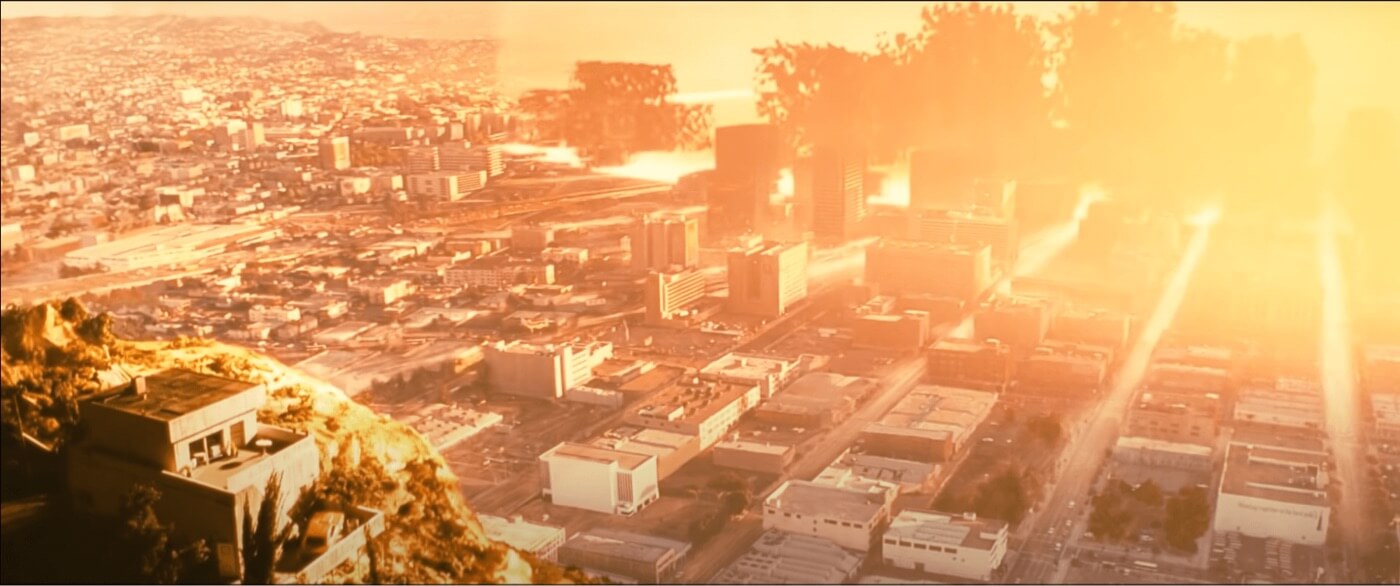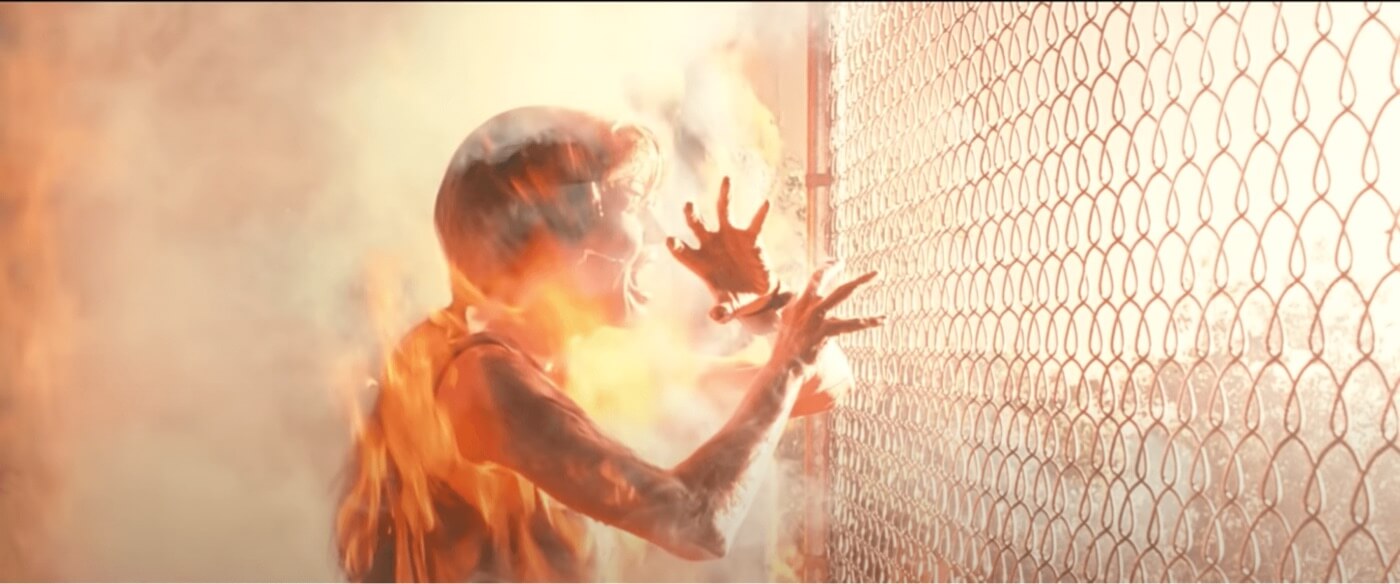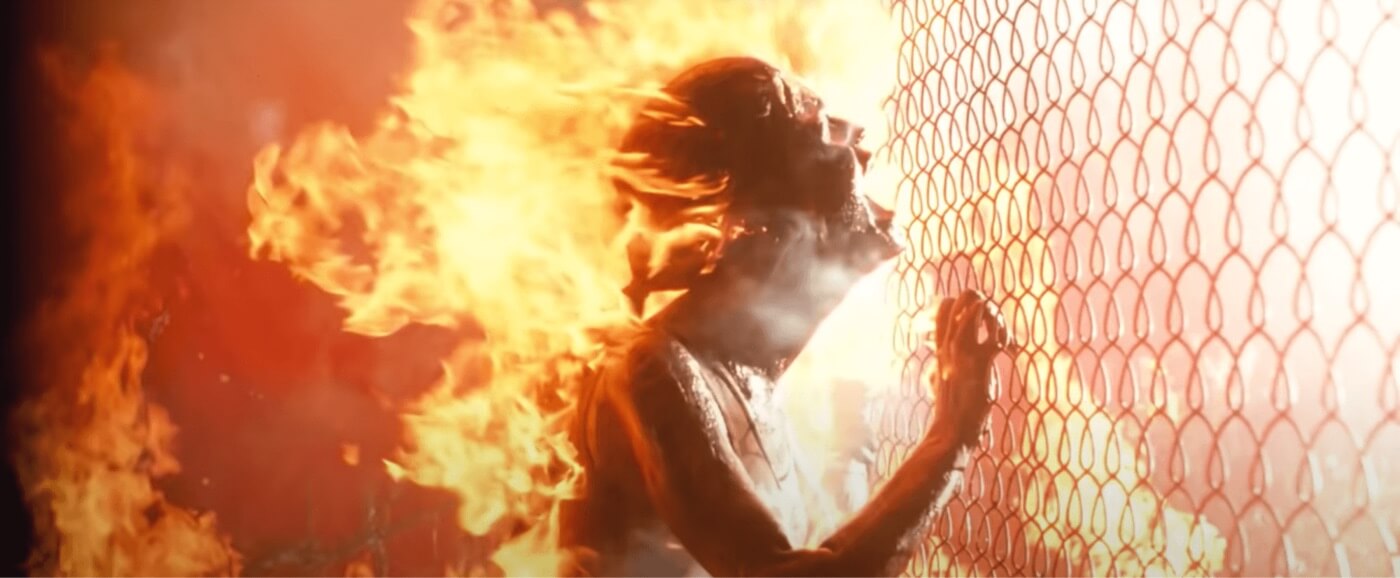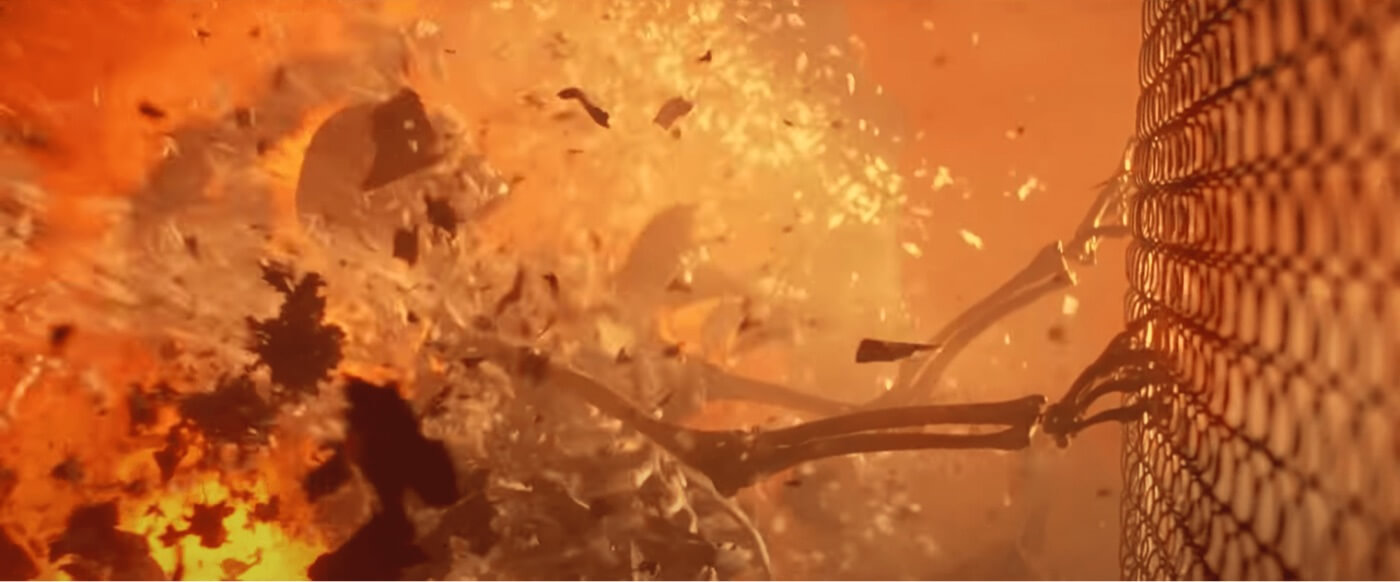Terminator 2: Judgement Day has a plethora of memorable scenes, from Sarah Connor’s hospital escape to the fiery climax at the steel mill. Perhaps one of the most stunning sequences, however, is Sarah Connor’s nuclear apocalypse nightmare. The dream was vividly realized by James Cameron and his team, and at the time was one of the most realistic depictions of a nuclear holocaust put to film. To pull it off, the filmmakers used groundbreaking techniques, some of which are still imitated today. Let’s break down the Terminator 2 nuke scene in all its apocalyptic glory!
Terminator 2 Nuke Scene
Building the Blast
Before it destroyed the entirety of Los Angeles, the Terminator 2 crew needed to create the nuclear bomb’s instantly-recognizable mushroom cloud. Without a convincing explosion, the rest of the sequence would ring false.
Before we go any further, check out the nightmare in its horrific entirety below.
Watch the Terminator nuke scene
This sequence didn’t happen without extensive planning for each and every shot. Take a look at a storyboard we assembled using StudioBinder's storyboard creator. Click the image to see the entire sequence.
Terminator 2 Nuke Scene Breakdown • Click to view the shot list
You can distinctly make out the mushroom cloud looming over the L.A. skyline. As much as possible in T2, James Cameron tried to do stunts and effects for real, but even with his massive budget, he wasn’t able to actually detonate a nuke. So he turned to special effects studio 4Ward Productions.
Robert Skotak, one of the heads of the studio, decided that some of the explosion could be a practical effect (rather than CGI, which was still in its nascent stages in 1991). But simply scaling up a smaller, more controlled explosion wouldn’t do the trick because it wouldn’t have a mushroom shape.
So Skotak cooked up an out-of-the-box idea. He pitched to his team that perhaps a dancer, put in a costume that looks like a cloud, could act out the movement of an unfurling nuclear blast. Most of the 4Ward employees who heard the suggestion were thoroughly unconvinced.
Instead, Stotak and his team created the blast out of pieces of plexiglass. They filled each piece with fiber-fill, joined them with rotating hinges, and attached them to cables. When pulling the cables, the creation would look like a mushroom cloud.
Finally, to make it seem as though the cloud was filled with fire, the crew, led by Mark Shelton, made rotating gels which, combined with a backlight, simulated roaring flames.
This expanding cloud was filmed and the cables were removed digitally. The final cloud, which in reality was only 8 feet tall, was then composited into the Los Angeles skyline. With a little bit of deliberate overexposure, the limited mobility of the cloud was masked.
Terminator 2 Nuke Scene
A Miniature City Destroyed
Contrary to popular belief, James Cameron did not raze the entirety of downtown Los Angeles for the Terminator 2 nuke scene. Instead, 4Ward Productions created elaborate miniature sets.
While Cameron didn’t want to actually blow up the City of Angels, he did in fact want to blow up the entire miniature set using TNT in the middle of the desert. 4Ward heads argued that this wasn’t a great idea, since an actual explosion is hard to predict and hard to do legally.
The first shot the team had to tackle was this high-angle wide shot:

Terminator nuke scene
The shot required several steps. First, to get the pre-nuke footage of the city, stills were taken via helicopter. Then, matte painters Rick Rische and Richard Kilroy used one of the selected stills to create a post-nuke city — matching the angle, lighting, and color palette, but painting rubble where there once were buildings.
Now that the team had the before and after, they needed to figure out how to get from point A to point B. First, they used in-camera exposure to wipe from the aerial shot to the matte painting. But of course, without anything else, this just looked like a transition. The team needed to show the buildings getting destroyed.
Initially, they thought they could do it practically, by destroying the miniatures while they were heavily backlit in order to simulate the light from the blast. They tested the strategy with one miniature building, and the result was promising — but there was a big problem.
It would be a huge lift to replicate the destruction for forty miniature buildings, which would be necessary to fill the entire frame.
“I got a call and was told Jim’s on the phone… And Jim goes, ‘This is my favorite f***ing shot in the movie. Listen, listen, we’re doing the sound mix…’ That was great, you know, to get a call like that.”
— Robert Skotak on James Cameron
So the team pivoted to a digital solution, opting to show the building crumbling via CGI. But still, Skotak wanted to make sure they were sticking as close to reality as possible. As a reference, he filmed matzo crackers being destroyed by hammers. This footage was sent to Electronic Image, the company which would do the digital effect.
The resulting CGI contained black buildings on a white background disintegrating. This made the compositing process simpler, and the buildings didn’t need to have any color because they were supposed to be silhouettes anyway.
The digital graphics were used to transition from initial still to desolate matte painting.
To add a bit of depth, a house was added to the foreground. It was also a miniature, about 1/12 scale. The dwelling, complete with miniature furniture, was placed in front of a black background and blasted with high-powered air cannons.
All this work went into a shot which lasts just a few seconds. But it lingers in your head for a whole lot longer.
Terminator 2 Nuke Scene
Additional Miniature Work
4Ward wasn’t done with miniatures just yet for the Terminator nuke scene. To fully sell the apocalyptic nature of the explosion, the team captured insert shots on specific parts of Los Angeles getting blown away.
And when we say blown away, we mean that literally. The team used large air cannons to tear apart elaborate miniature sets.
Miniature set • Terminator 2 behind the scenes
To make sure the buildings were in fact torn apart, the 4Ward crew built them with pyrocel mixed with gypsnow. This material was highly breakable, and had to be supplemented with wire framing.
But even though the buildings were incredibly fragile, it still took a lot of air power to take them down, sometimes requiring up to eight fans. During takes, sand bags attached to the facades of the buildings via pulleys would be triggered so that the buildings would collapse backwards.
The bending palm trees also had to be cheated. Because their trunks didn’t have much surface area, the miniature trees didn’t blow back from the air cannons as much as the effects teams would have liked. The trees were therefore rigged with wire pulls which were activated when the blast hit.
After the meticulously detailed sets were built, the team had a heart-sinking realization. Their sets were made so that the explosion would hit them from left to right. The live action footage which had already been captured had the explosion going from right to left.
The team didn’t have enough time to rebuild the sets, so they used a front-facing mirror to flip the scene in front of the camera. This meant that the only additional work necessary was painting all visible lettering backwards.
Each take was filmed at 120 frames per second, allowing for slow-motion. The resets between takes were laborious, sometimes taking up to three days as crew members cleaned up and located pieces which had been blown away.Related Posts
Terminator 2 Nuke Scene
Disintegrating Bodies
Perhaps the most disturbing visuals in the Terminator 2 nuke scene are of Sarah Connor and other women and children being vaporized. The effects were so disturbing that they even troubled members of the crew who made them. Take a look at this interview with effects artist Stan Winston:
Terminator playground scene
To pull off the iconic shot of Sarah’s flaming body clinging to the chain link fence, the T2 team built three puppets based on Linda Hamilton’s likeness. Because Hamilton was unable to maintain the tortured expression on her face for long enough for a lifecast to be made, the crew scanned her face with Cyberware and used that digital information instead.
The flaming Sarah puppet included two arms that were attached to cables, as well as a moveable jaw. The puppeteer for the scene had to wear a fire-proof suit covered in fire gel so that he could get close enough to the flames to operate the Sarah mannequin.

The first puppet • Terminator 2 nuclear scene
The second puppet depicted a more thoroughly burnt Sarah. This puppet was covered in flammable rubber cement which was lit through squib sparks.

The second puppet • Terminator playground scene
The third and final puppet, which would reveal Sarah’s skeleton, was built by Shannan Shea. Shea reinforced a medical demonstration skeleton and lined the mold of Sarah with tissue paper and tempera paint. When this material dried, it was filled with shredded napkins and placed over the skeleton.
This fragile puppet was then blasted with air cannons, resulting in the final disturbing visual:

The final puppet • Terminator 2 nuclear scene
This strategy (sans skeleton) was used for the other ashen figures in the park.
All of these painstaking effects make the Terminator 2 nuke scene one of the most instantly memorable nightmare sequences in cinema history. Shockingly, it’s only one of the groundbreaking sequences in a film chock-full of them.
Up Next
Making of Avatar and Avatar 2
James Cameron didn’t rest on his laurels after changing the game with Terminator 2. He changed it again with Titanic. And then again with Avatar. Check out how he pulled off the highest-grossing movie of all time.
Up Next: Making Avatar →
Showcase your vision with elegant shot lists and storyboards.
Create robust and customizable shot lists. Upload images to make storyboards and slideshows.
